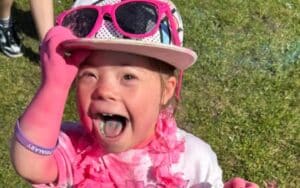Parenting a child with speech and language concerns presents unique challenges and opportunities. Effective communication is a vital skill and modeling language is an extremely important strategy to support a child’s development. In this article, we will explain the concept of modeling language, why it is important, techniques that can work at home, and resources related to modeling language.
Understanding Modeling Language
Modeling language involves demonstrating language usage to your child. This happens during daily interactions. Modeling language encompasses pronunciation, vocabulary, sentence structure, and the nuances of communication. By actively and consistently exposing your child to your language, you provide a valuable foundation for their speech, language, and communication development.

Why Modeling Language Matters
Modeling language is a cornerstone of communication development for children. Here’s why it’s indispensable:
- Enhanced Imitation: Children learn by imitation. When you consistently say/model, “Let’s put on your shoes,” your child is more likely to come to understand and imitate the word, “shoes.”
- Vocabulary Expansion: Consistent exposure to varied language enriches your child’s vocabulary. For instance, if you say/model, “We’re going to the park,” your child learns the meaning of the word “park” by associating the word with the place.
- Improved Comprehension: Accurate language modeling enhances your child’s ability to understand vocabulary, directions and location words. If you say/model, “I’m putting the teddy bear on the table,” overtime, your child learns to understand and later follow the direction, “Put the teddy bear on the table.”
- Boosted Confidence: When you actively model and respond to your child’s language and language acts, you empower and encourage them to communicate more with you.
- Creating a Language-Rich Home Environment: Your consistent modeling of language fosters a home environment conducive to language development. Modeling language during mealtime, bedtime, toileting, and other routines and experiences enriches your child’s understanding and use of speech, language, and communication.
When and How to Model Language
Modeling language for your child can’t begin too early in their development or happen too late in their development. Continue or begin to incorporate modeling into your child’s daily routines and experiences. Here are a few tips:
- Talk Frequently: Engage in conversations with your child throughout the day (even before they can respond back). For example, during bath time, you can say, “Let’s take off your clothes. First your shirt, now your pants and socks. Let’s get in the warm water. Wow, it’s so wet. Let’s wash your face.” Talk throughout the bath experience and use similar strategies during other experiences.
- Narrate Activities: Describe what you’re doing and what your child is doing. While cooking, you might say, “I’m chopping vegetables, chop, chop, chop.” While playing, you might say, “Ball, big ball, let’s roll the ball.”
- Model the Responses to Open-Ended Questions: Help your child to respond to questions by asking a question and modeling the answer like, “Hmmm, what is this (point and show)? It’s a ball.”
Techniques for Effective Modeling
Enhance your modeling skills with these techniques:
- Routines: Model/demonstrate the use of language as you and your child go through daily routines and experiences.
- Repetition: Consistently repeat and demonstrate key words in a variety of contexts.
- Expanding Speech: Expand on your child’s utterances, transforming short phrases into full sentences. If they say, “Want juice,” you can say, “You want more apple juice.”
- Introduce New Words: Highlight and integrate new words into routines and conversations to expand your child’s vocabulary. While playing with blocks, you can introduce and reinforce words like ‘stack’ and ‘tall.’ While cooking together, introduce words such as, “bowl,” “crack,” and “stir.”

Modeling Language During Daily Routines
To further integrate language modeling into daily routines, consider these examples:
- Cooking and Mealtime Conversations: During cooking and meals, name and describe the food, its color, shape, texture, etc. For example, “This broccoli is green and crunchy.” Name, describe, and demonstrate actions associated with cooking such as, wash, mix, stir, pour, and crack.
- Getting Dressed Dialogues: While dressing your child, talk about the clothing items. “Let’s put on your blue shirt first, and then your cozy red socks.”
- Bath time Vocabulary: During bath time, discuss body parts and actions. “We wash your hair with shampoo. Now should we wash your toes?”
- Bedtime Storytelling: Reading a bedtime story is an excellent opportunity to model language. Emphasize, point to, and repeat important vocabulary you read or shown in the illustrations. For example, “Look at the cat. He is on the chair.”
- Grocery Store Narration: While shopping, name and describe items. “We need to buy apples. Apples are round and red. Let’s see, can you find the apples?”
Modeling Language During Playtime
Make learning language during playtime an enjoyable opportunity to model language. Here are a few ways:
1. Storytelling
- Example 1: Use picture books and name and talk about what you see and what is happening.
- Example 2: Use different voices, vocal inflection, and rate of speech to emphasize key words, phrases, and concepts.

2. Pretend Play
- Example 1: Model language to label, describe, ask and answer questions, and narrate pretend play.
- Example 2: Use descriptive language and conversation during a pretend tea party or monster truck rally.
3. Toy Play
- Example 1: Play with alphabet or number blocks and say, “Let’s find the letter ‘A'” or “Let’s count the balls, one, two, three, etc.”
- Example 2: Use shape sorters to introduce and name shapes like ‘circle’ and ‘triangle.’ Name the shapes as they are picked up and placed.
4. Sensory Play
- Example 1: Explore textures with items like soft fabric, sand, and water, describing how they look and feel and comment on what you are doing and can do with them.
- Example 2: During sensory play, talk about colors, temperatures, smell, sound, taste (if using food items), and feel.

5. Nature Adventures
- Example 1: While on a nature walk, name and talk about the sights and sounds around you. “Listen to the birds singing. Let’s look for the birds.”
- Example 2: Collect flowers, leaves or rocks and name and describe them, explore and discuss their shapes, colors, smell, and textures.
Tracking Progress and Patience
The rate of language development varies for each child. Be patient and vigilant as your child moves forward to their personal best:
- Celebrate Small Achievements: Recognize and celebrate effort and growth.
- Consult a Specialist: If your child struggles with speech sounds or language development, seek guidance from a speech-language pathologist.
FAQs
How can I start modeling language with my child?
Modeling language means consistently talking with your child. In other words, demonstrating the use of language. Narrate daily activities, ask and model answering open-ended questions, and respond patiently and in a timely to their attempts at communication.
Are there any specific techniques for modeling language?
Yes, add words to what your child may be thinking, doing, or experiencing. Expand on your what your child says, reinforce and introduce words during conversations, and utilize visual aids and gestures.
What if my child has difficulty imitating speech sounds?
Consistently model language but do not require them to repeat. Consult a speech-language pathologist for individualized guidance. They can provide an evaluation as well as insights, collaboration, strategies, and intervention.
Can modeling language be integrated into playtime?
Absolutely! Incorporating modeled language into playtime is not only effective but also fun for both you and your child. Here are some ways to do it:
- Name and Describe: Talk about what your child and you are using, doing, and experiencing during play. Emphasize important words and repeat them in different contexts.
- Role-Play Scenarios: Create imaginary scenarios with toys or props and model and encourage your child to engage in conversations between characters. For instance, you can set up a pretend restaurant and have your child play the waiter or the customer.
- Story Photos: Use photo images and take turns talking about them. Then, together, weave a story using the images. This activity encourages narrative skills and creativity.
- Building Narratives with Toys Such as Blocks: As you build with building toys, describe what you’re doing and ask your child to do the same. For example, “I’m building a tall tower. What are you building?” If they cannot yet answer, model the answer to your own question. Use words to build on the story.
How can I make modeling language fun for my child?
Engage in activities your child enjoys, such as while actively modeling language. Here are some additional ideas:
- Musical Moments: Singing songs with repetitive lyrics helps children learn new words and sentence structures. For example, while singing “Twinkle, Twinkle, Little Star” and emphasizing the words ‘twinkle’ and ‘star’ and use gestures to go along with the words.
- Art and Crafts: While creating art, talk about the colors, shapes, and materials being used. Ask questions like, “Tell me about your painting. I like the way you use the blue marker to make a circle.?” If they do not answer, model the answer.
- Cooking Together: Cooking offers numerous opportunities for language modeling. Discuss the ingredients, their textures, and the steps of the recipe. “We need flour to make pancakes. Let’s pour it in the bowl. What’s next?”
Additional Resources
Here are some valuable resources to aid you in supporting your child’s language development:
- Modelling-and-Recasting-to-Support-Speech-and-Language.pdf (ncse.ie)
- Language Modeling as an Efficacious Early Language Intervention Approach With Young Children Demonstrating Complex Communication Needs | Perspectives on Augmentative and Alternative Communication (asha.org)
- Language Modeling for Young Learners (thinkaplus.com)
- Language-building Tips for Parents of Young Children (hanen.org)
Summary/Conclusion
Modeling language is an invaluable strategy for nurturing your child’s speech, language, and communication skills. With dedication, patience, and the wealth of resources available, you can empower your child to thrive along their language development journey. Your consistency and commitment are the cornerstones of their success, and every step forward is a remarkable achievement.




0 Comments